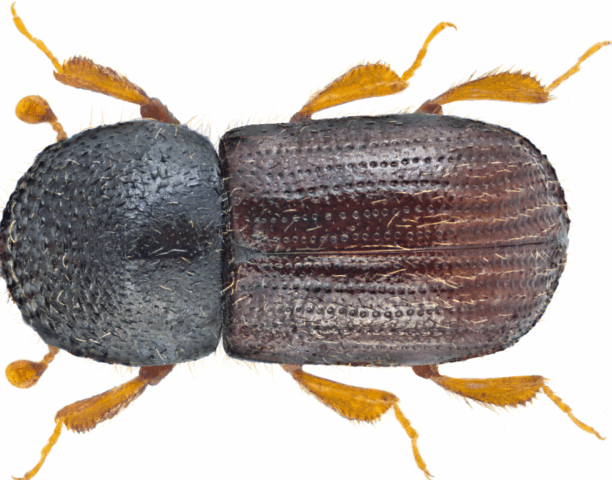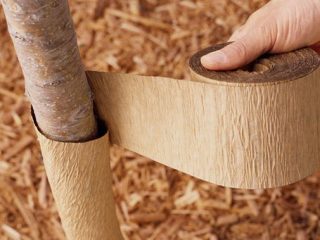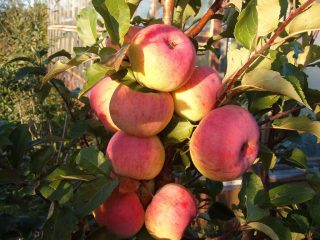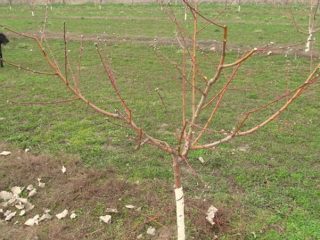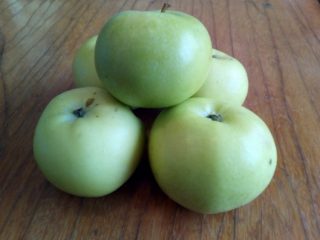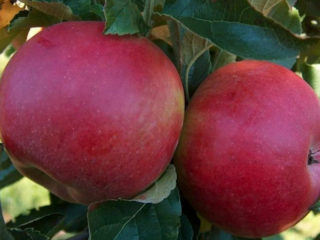Content
The bark beetle on an apple tree is a dangerous beetle that feeds on wood and can lead to the death of the tree. You can fight it only at an early stage. If the sawdust that appears after the activity of the bark beetle is white, the apple tree will have to be cut down. It is better to destroy the tree than to allow the insects to spread to other seedlings.
Description of the bark beetle
The bark beetle is a beetle that lives on apple, pear and some other fruit trees. It goes through two stages of development:
- Imago (adult insect) are beetles with an underdeveloped rostrum. The body is dark brown, divided into a head and abdomen. The sizes are small - up to 9 mm in length. The front legs perform a digging function and have serrations on the shins. Insects have wings and fly freely.
- Bark beetle larvae on apple trees resemble weevils; the color is white, yellow, or sometimes with a brown tint. They have no wings and move only on the surface.
Adult beetles gnaw through plant tissue and make passages, then form nests in which they lay eggs.Within a few days, the larvae hatch from them. They are very voracious, actively feeding on plant juices. The development cycle is long - the larva turns into an adult bark beetle in 70 days.
Pests are common in almost all regions of temperate climates. There are two types of beetles most commonly found:
- Fruit sapwood or apple bark beetle.
- Gypsy beetle.
Sapwood most often settles on old and diseased apple, pear, and apricot trees. And the gypsy beetle attacks mainly healthy crops.
Survival of an apple tree after a bark beetle invasion
It is quite difficult to remove the bark beetle from the trunk of an apple tree, since it settles inside and may not manifest itself for a long time. Therefore, if the first signs are discovered (holes in the bark), it is already necessary to begin exterminating the pest as quickly as possible.
Bark beetles pose a great danger, since the larvae are very voracious and literally grind down the inner layers of wood. As a result, the apple tree is seriously injured and deprived of water and nutrients. This leads to a drop in yield and the tree stops growing. It can die not only from bark beetles, but also from pathogenic fungi spread by beetles.
The survival rate of an apple tree depends mainly on the degree of damage:
- If there are not many holes in the bark, the wood does not flake off, the sawdust is brown, brown in color, you can still deal with bark beetles.
- If the wood is exposed, winding passages are observed, and the bark is white, which means that a significant part of the apple tree is affected. In most cases, it is impractical to treat it - it is better to destroy it before autumn and carefully treat the area so as not to infect neighboring plantings and prevent the pests from overwintering.
Symptoms of the lesion
Apple bark beetles (pictured) are quite large, so they can be seen with the naked eye. The main symptoms of the lesion are:
- small holes on the surface of the barrel;
- holes on branches;
- a pile of small sawdust near insect habitats;
- the tree looks emaciated and lags behind in development;
- shoots suddenly dry out and stop growing;
- flow of gum from small damage (diameter 1-2 mm);
- peeling of the cortex;
- the wood is exposed, winding passages are visible - this is the last stage, which often ends with the death of the apple tree.
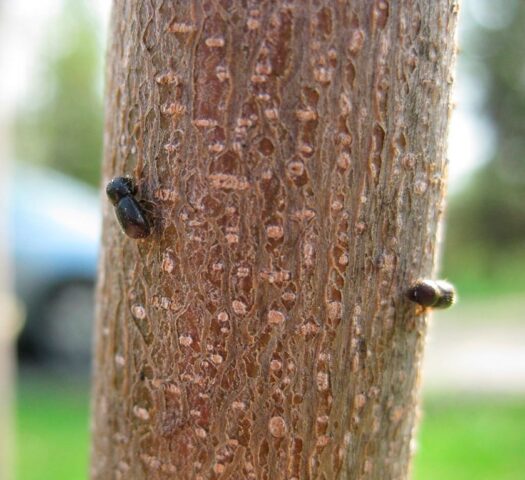
The apple bark beetle is easy to identify visually
If small sawdust is found, this is a clear sign of damage. Moreover, you should pay attention to their color:
- brown, brown - bark beetles gnaw through phloem tissue, i.e. outer shells;
- white - deep damage, the tree may not recover.
Thus, you need to carefully study the external signs of damage - they may appear as early as June. If you start treatment right away, the apple tree can be saved.
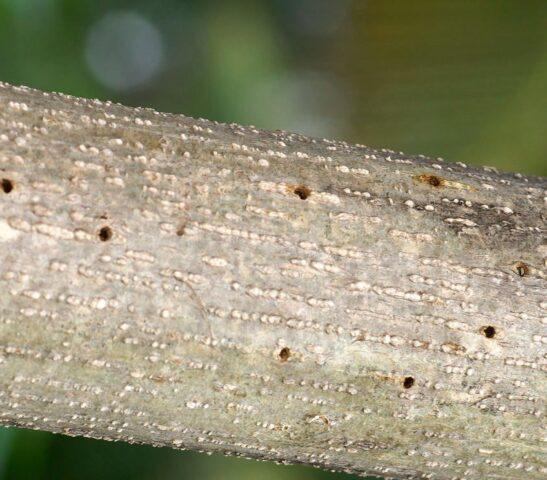
The main sign of damage is the appearance of small holes
Reasons for appearance
The pest is distributed quite widely - from the middle zone and south to Siberia, Transbaikalia, Yakutia, Sakhalin and Kamchatka. Therefore, it is impossible to completely insure against its occurrence. But there are several factors that provoke the invasion of bark beetles on apple trees and other trees:
- relatively warm, not too hot weather;
- cracks, cuts and other damage to the bark;
- plant remains on the site;
- lack of preventive treatments and thinning pruning.
It is important to understand that bark beetles are attracted to the smell of fresh wood.Therefore, you need to immediately remove all cut branches, as well as fallen bark, pay attention to cracks on the trunk, and, if necessary, immediately cover them with garden varnish.
How to deal with bark beetle on an apple tree
The fight against the bark beetle can be lengthy, and not one, but several means are used for destruction. Chemical preparations show the greatest effectiveness. Along with them you can put traps and repellers. If the invasion is minor, folk remedies also help.
Chemical preparations for bark beetle on apple trees
Chemicals are most effective for treating trees and preventing beetles. They can be used at the invasion stage and in early spring. It is necessary to observe the waiting period - the minimum period from the last spraying to harvest. It can range from 5 to 30 days. Before starting work, you need to prepare the container itself (sprayer), gloves, mask and special clothing.
The following insecticides are most often used to kill pests:
- "Calypso";
- "Confidor";
- "Anti-bug";
- "Iskra-M";
- "Arrivo";
- "BI-58";
- "Bitoxibacillin."
Advice! The first treatment against bark beetle on an apple tree should be carried out at the end of April or beginning of May. The main criterion is that the daytime temperature remains consistently above 15 °C.
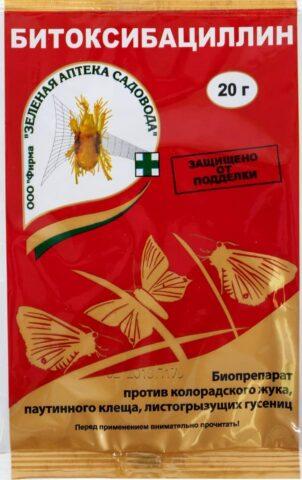
"Bitoxibacillin" is a biological insecticide that can be used at the fruiting stage
Traps and repellers
You can also get rid of the bark beetle on an apple tree by mechanical means - using traps and repellers. Beetles are most often lured using the following means:
- In the spring, after pruning, branches of various trees and shrubs are placed away from apple trees and 3-4 weeks after the end of summer, the bait is carefully burned.
- Mechanical collection of beetles by hand is carried out after the start of flowering (within 15-20 days), i.e. from mid-May to the first ten days of June.
- Special repellers - tapes, tablets.

Such products are used only in large gardens to lure and subsequently destroy various pests.
Syringing the barrel
Syringing is a specific method that is suitable for treating trees. It shows effectiveness only in the early stages of damage to the apple tree, when there are not many holes in the bark and the sawdust is brown or brown in color. To do this, you need to prepare a concentrated insecticide solution - you can choose from this list:
- "Chlorophos";
- "Tanrek";
- "Karbofos";
- "Calypso";
- "Anti-bug";
- "Confidor".
The solution is drawn into a large syringe (can be purchased at a pharmacy with a volume of 150 ml) and several injections are made in the barrel, especially in the affected area. For prevention, syringing is done not only for sick trees, but also for healthy trees. After the procedure is completed, the surface is treated with garden varnish. After two weeks, re-treatment must be done. A third time may not be necessary - you need to inspect the apple tree.
Fighting bark beetles on apple trees with folk remedies
Folk remedies also help to destroy the bark beetle on an apple tree. They give results in the early stages of the lesion. They are also used for prevention. Among the main recipes are the following:
- Carbolic acid and any liquid soap (2 cups each) per 5 liters. The resulting concentrate is diluted with water four times - two buckets of the finished solution are obtained. Mix thoroughly and begin treating the apple tree against the bark beetle.
- Take crushed rosin in an amount of 1 kg, add 230 g of drying oil and mix with hot molten paraffin (5 kg). This mixture can be used along with garden varnish to treat trunks.
- Place 50 g of wax and rosin in a container, add 200 ml of vegetable oil. The mixture is heated until completely dissolved and used as putty.

You can destroy the bark beetle using rosin
Boosting immunity
Along with treatments, it is necessary to take measures to increase the immunity of the apple tree. Even if the variety is not genetically resistant to the bark beetle, the crop can still be effectively protected from beetles:
- Carefully do the cutting, use only well-sharpened tools, pre-treat the blades in a 1% solution of potassium permanganate or other antiseptic.
- Do not push ladders or other heavy objects against the trunk, so as not to cause even slight damage to the bark.
- If there are wounds, cracks, or damage on the surface of the trunk (for example, from a woodpecker), it is necessary to treat it with any folk remedy, after which it is necessary to cover the cracks with garden varnish or mash with clay and manure (1:1).
- Provide normal care - watering, fertilizing and other measures (taking into account the characteristics of a particular variety).
Prevention
It is not always possible to remove the bark beetle from an apple tree; it often happens that the tree has to be cut down and destroyed. To prevent this from happening, experienced gardeners recommend following preventive measures. The basic rules are:
- Treat the apple tree against bark beetle in the spring with insecticides or folk remedies, and set traps.
- Carry out regular pruning and immediately remove all plant debris so as not to attract the pest with the smell of fresh wood.
- Avoid sawing wood near the garden for the same reason.
- Water the apple tree regularly, especially during drought.
- Prevent the proliferation of weeds in tree trunk circles, do loosening and weeding.
Apple tree varieties resistant to bark beetle
All varieties of fruit and coniferous trees are susceptible to attack by this pest. Therefore, you can choose any crops, provided that they are suitable for growing in a particular region.
Conclusion
The bark beetle on an apple tree is very dangerous, and no one is safe from its invasion. Therefore, when growing a tree, you need to pay attention to its appearance, and if necessary, immediately carry out processing or syringing.

